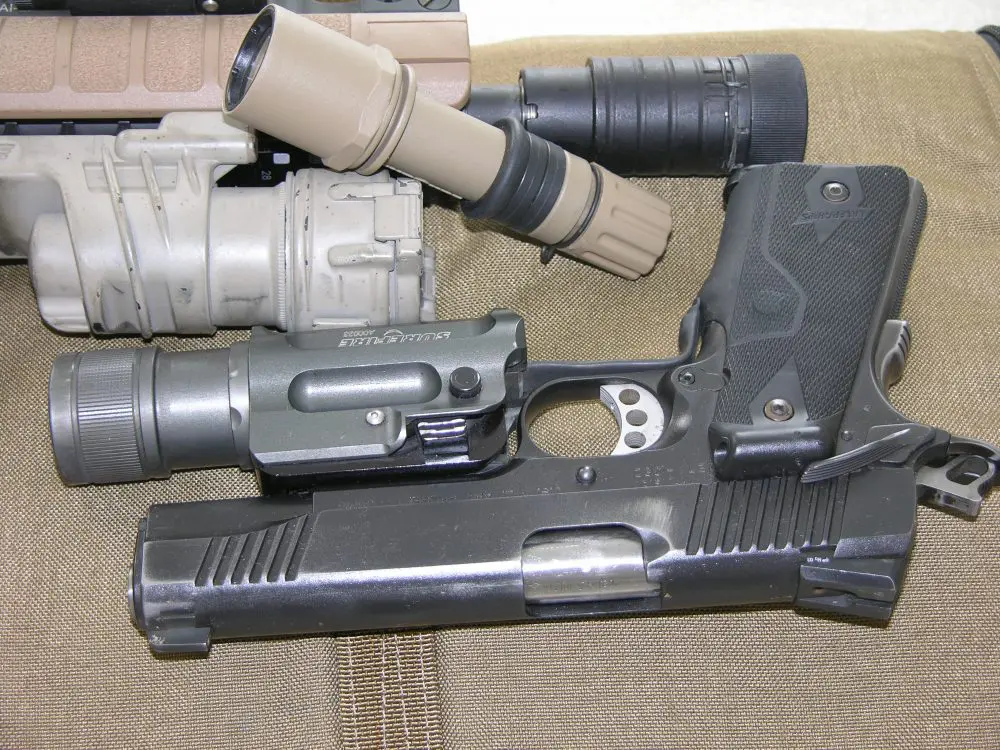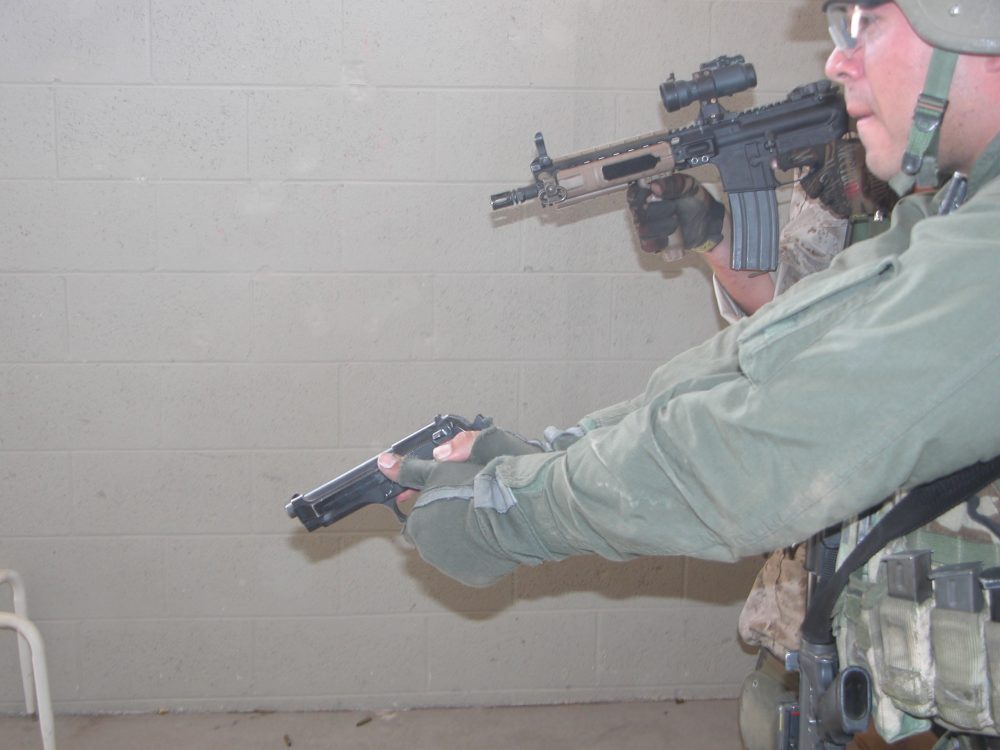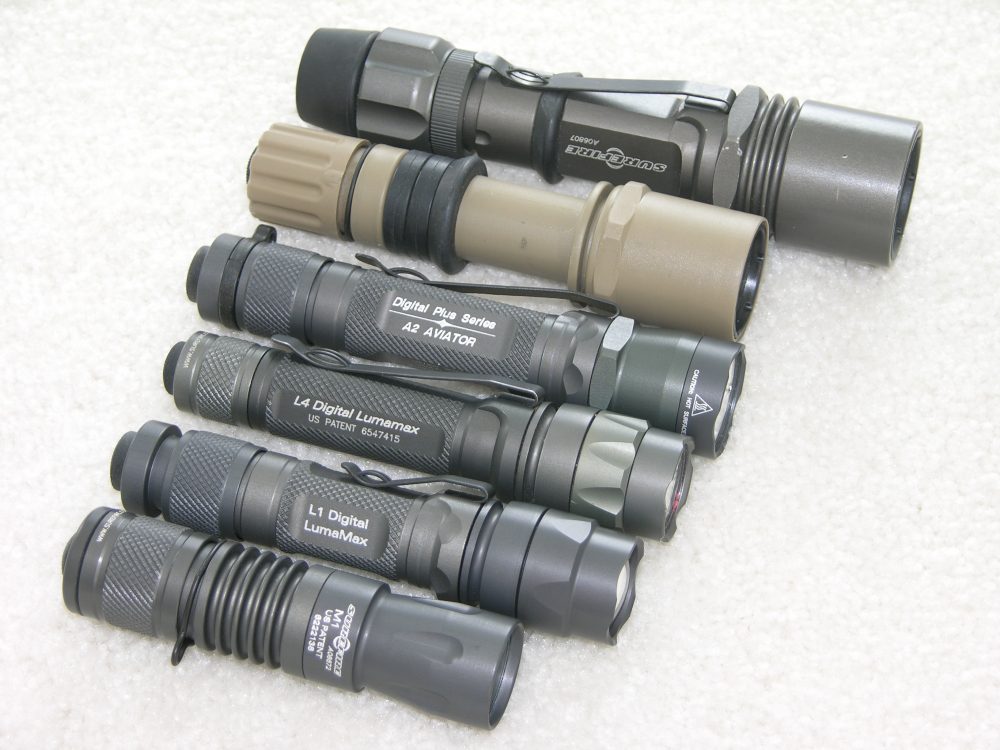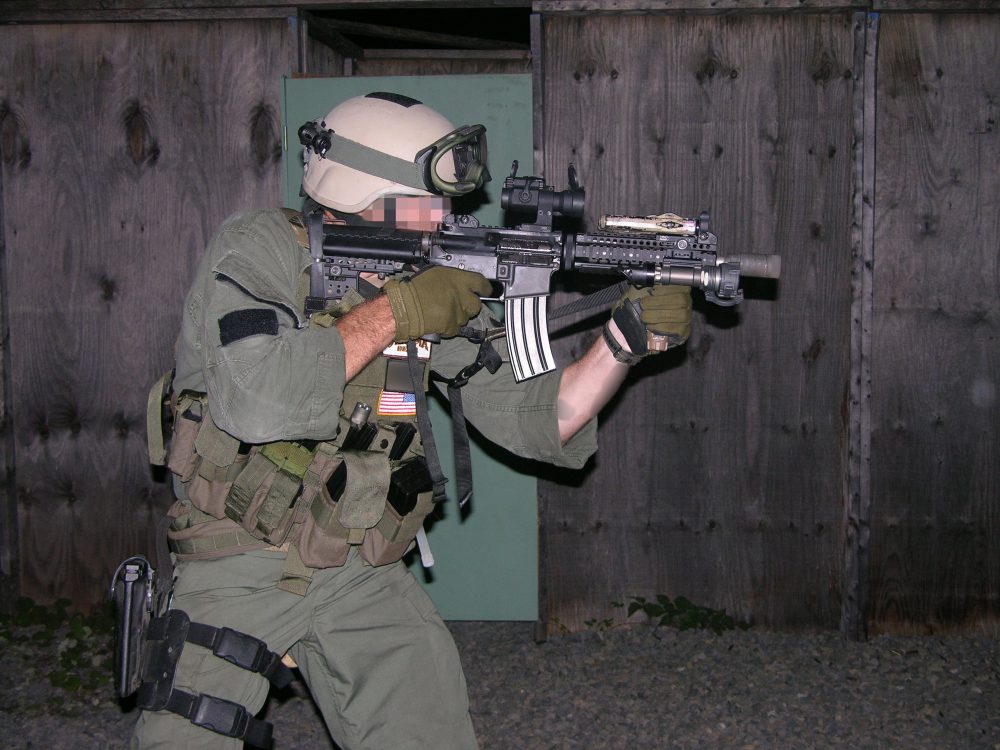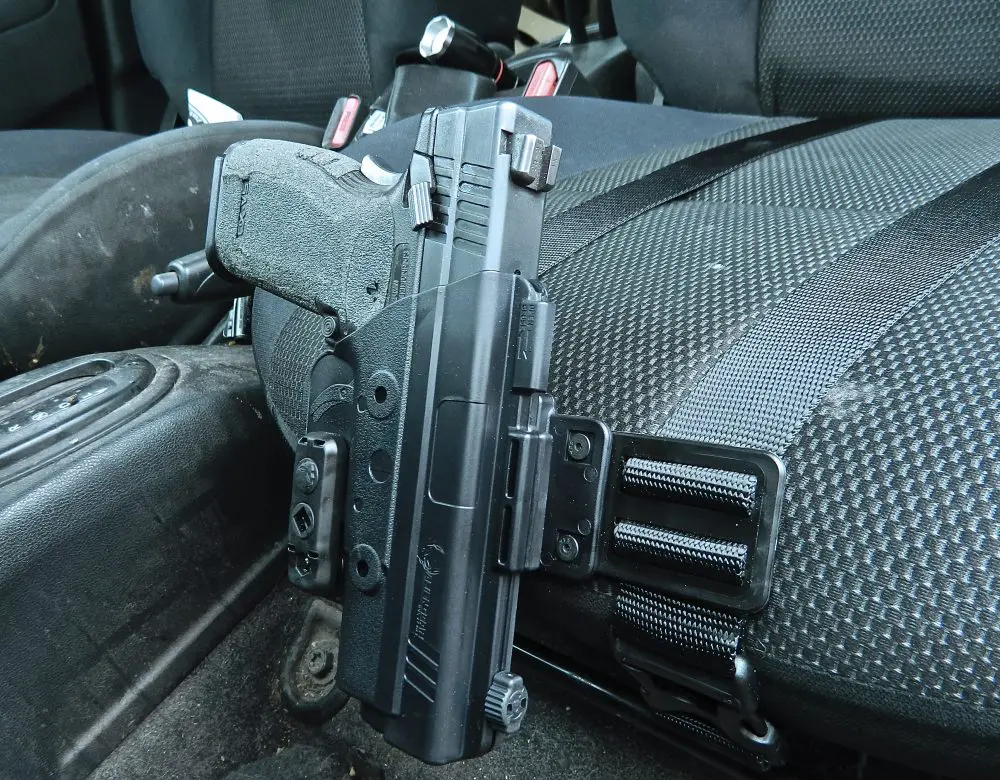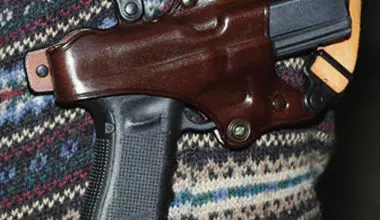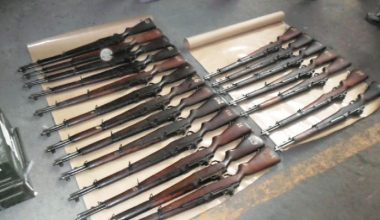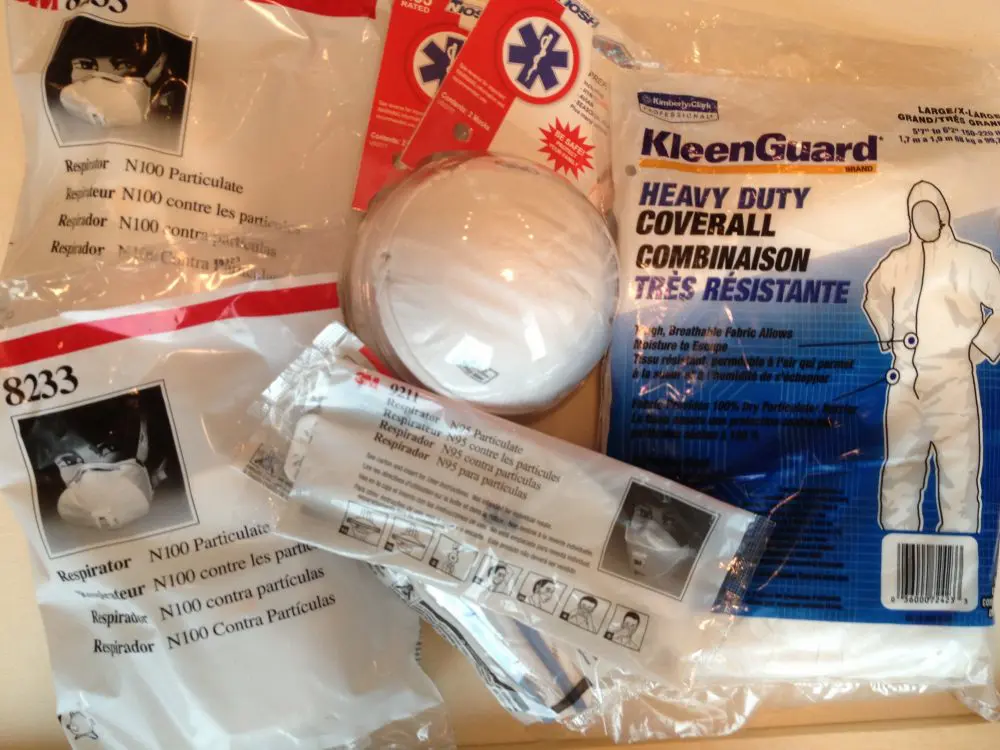The use of weapon-mounted white lights always sparks a significant amount of controversy. The majority has to do with Tactics, Techniques and Procedures (TTP) concerning how to properly employ lights. The simple fact is that target acquisition is the first step in the engagement process. Simply finding a potential threat, even in bright light, may not always be easy—and in low light it is even more difficult.
Once someone is acquired, they have to be identified. No matter what your occupation or situation is, the need to properly identify a potential threat is paramount. Failing to identify a threat may mean that the bad guy has sufficient time to put you into the hurt locker. Engaging a good guy means that life—as you knew it—will be drastically changed, and you will live out your remaining days with the horrible realization that you have shot at, injured or killed someone who wasn’t a threat. The legal, moral and ethical implications of such an act may be difficult to comprehend, but that is exactly what hangs over the head of everyone who carries a gun.
The M910 on the M4 Carbine is an example of a light on a primary gun; the Military Light on the ICQB is likewise an example of a weapon-mounted light on a secondary weapon. The G2Z (center) is a very useful tertiary light. All three are SureFire products, and all are issued lights.
For police and certain military applications, a weapon-mounted white light on their rifles, carbines, shotguns and sub-caliber machine guns is pretty much standard. That six- or nine-volt light not only projects a sufficient amount of illumination to search danger areas, but also to identify someone that may be hiding therein. If that individual is a threat, white light can also provide the means for you to deliver rapid, accurate shots into that threat, consistent with the appropriate laws or Rules of Engagement (ROE). A useful byproduct of the light is that it can also distract or disorient someone on the downrange side, giving you another edge.
Some will argue that the white light is a bullet magnet, and does nothing but attract attention. While there is no doubt that you will be #1 on the hit list of someone who hates you, what are the options? If you are tasked with making entry into a location, executing a warrant, conducting an In Extremis Hostage Rescue (IHR) or even searching your own domicile, that white light is absolutely necessary if you are to acquire and discriminate between a threat and a non-threat. There is no magic, and you will not be able to miracle your way through a legal proceeding after you shoot someone who didn’t need shooting.
Remember that during daylight, the bad guy and you are on equal visual terms. You can see him unaided, and he can likewise see you. You may be all that is standing between him and freedom, jail or death. With or without that light, you are still a bullet magnet. There is no free lunch.
We train for worst-case scenarios, and part of that training is to handle malfunctions with the long gun. Under certain circumstances the “A” answer is to transition to your pistol. However, in dim or low light conditions you may face another issue, and that is how do we see—and identify—the threat if the pistol is without a light?
With his M4 down due to poor frangible ammunition, this shooter has transitioned to his M9 pistol. No light is mounted, and while there is enough ambient light in this shoot house, what happens if he needs to search a closet? Will he be able to acquire and engage the threat?
This can be accomplished in two ways: mounting a light directly to the weapon, or using a flashlight and one of the many handheld flashlight techniques.
White lights on pistols are becoming very common. All of the major pistol makers offer rails on some of their guns, and for cause.
Using a weapon-mounted light has many advantages, to include being faster to use; being able to use the light if you have to shoot one hand, unsupported; and provides for a more capable light system. The fact that the light is coaxial to the bore means that most of the light will be pointing in the same direction as the gun—something not always possible when using a handheld light.
Some in the business who are very knowledgeable about this subject are all about having a weapon-mounted white light on a long gun, but do not want any lights on the pistol. They prefer to always use a handheld light with the pistol as this combination gives them options not available with a light mounted on the pistol. Their arguments for this are compelling, but a great number of other equally astute shooters prefer to have a light mounted on the pistol. As with everything else in the world, there are pros and cons at work.
One common refrain for a separate light is that you shouldn’t be pointing your gun at something you are not willing to destroy. If you use a handheld light you can identify the threat with the handheld light and then bring the pistol up to engage. According to this line of thought, there is never a reason to point a gun at someone who you are not going to shoot.
Common tertiary lights (from top): an M2, a larger, heavier and brighter light; a G2Z, an issue lamp in the Marine Corps Individual Assault Kit; an A2 Aviator, a dual output incandescent/LED light (the author’s favorite, especially useful with the red lamp or the new yellow/green lamp); an L4, a high output LED light; an L1, the dual output lower power light; and the M1, the IR Illuminator. As with all things, understand your needs and then get the very best that fits your needs.
The other side of the coin is that there may be insufficient time/distance for you to initially acquire a threat and then engage.
While Rule #2 is taken as sacred on the square range, it may be necessary to back up and ingest the proverbial chill pill. When a team goes in to rescue a hostage or execute a warrant, they will be searching with their guns up. The people in front of them will be hostages, unknowns, bad guys or friendly shooters—and you have to make the proper call in a heartbeat or two. If you are going to win this fight you will need to have the proper training, equipment and mindset, and be prepared to kill anyone that you bump into—if that is necessary. To do otherwise is flat stupid. Close Quarter Battle is by definition accomplished at short range, and that range can often be described as intimate. Consider that the average bedroom may be about ten feet by thirteen feet and you can get a feeling as to what close actually means.
We often say that “distance is our friend”, and that the greater the distance between us and our opponent the more time we will have to engage, but more precision is required. At closer range the opposite is true; less precision is needed, but the speed thing goes way up. At distance, our skill at arms kicks in, but up close luck comes into play—and that luck can be good for you or the bad guy.
Cops executing a warrant will point guns at everyone on the set until they have established positive control. Military personnel doing MOUT or Direct Action will surely be pointing weapons at everyone until they control the site. Cops executing a felony car stop will certainly be pointing their pistols/shotguns/carbines at all of the occupants of that motor vehicle until they are secured.
Safety Rule #2 states, “Don’t let the muzzle cover anything that you are not willing to destroy”. It doesn’t state that you can’t change your mind.
Under the above-described scenarios I am willing to shoot all if necessary, consistent with applicable law or ROE.
Common sense and good training, coupled with proper techniques and the application of good tactics, will be the difference between doing it right and either failing to engage a real threat or whacking a good guy. What is it that you want to do?
Another issue is what you do for light when you are trying to provide illumination for the medic who is trying to treat your partner for a sucking chest wound. Clearly flagging someone who is absolutely not a threat is contraindicated, so those lights on both your carbine and pistol are as superfluous at that point as the ammunition in their magazines.
As I am writing this article, the news is running video of how NYC is handling security on the subway system. They show NYPD Emergency Service Unit Officers completely jocked up and carrying their M4 carbines. Generally the weapons handling is very good, but in two clips it is horrible. In the first, a cop uses the muzzle of his M4 to open the lid of a trash can and illuminate the interior with the weapon-mounted M500 light. But in the second clip, the cop enters a subway car and illuminates the area under the seats with his weapon-mounted M500 light—something that is plain wrong.
The answer, of course, is to have a tertiary light—something not mounted on a weapon. The solutions are wide and varied, and often reflect that particular team’s frame of reference. Some, to include medical personnel, may wear a hiker’s headlamp on their helmet, leaving their hands free to work their lifesaving magic. Others may carry a small LED light around their neck to use as a low light source for specific tasks such as map reading, etc.
This very experienced shooter is negotiating a problem in the shoot house at Pat Goodale’s facility in West Virginia. While his carbine and pistol both have weapon-mounted white lights, he also has a SureFire L4 mounted behind his issued Carrier, Modular, 3 Mag M4A1 pouch. Like having a gun, a light is no good unless you can easily access it and have the training to use it.
However, a handheld flashlight may be the most useful (and used) of all the tertiary lights. Handheld lights are larger (though size is relevant); more robust; may be more capable (as in having different power settings or colors available) and throw more light (not always beneficial).
The tertiary light is not necessarily something that will be used to illuminate a threat, although it may be pressed into service to do exactly that. It is more of a utility light, used for one of those six million other reasons that you need a light for.
Among those are Sensitive Site Exploitation: searching for evidence or items of interest; prisoner search (Flagging the PW may be indicated, but flagging your teammate who is searching him isn’t.); clearing malfunctions in crew-served weapons (Yeah, the light means that they can see you, but the gun is broken because you have been shooting it, and they already know where all of those tracers were coming from.); and signaling with a flip-up IR filter (or the M1 IR Illuminator). An important use is to signal those behind you when backing up a tactical vehicle—a critical signal in combat. Dying in combat sucks. Dying because you were run over by a friendly vehicle is flat tragic.
While there are a great number of handheld lights on the market, my strong preference is to use only those lights that are purpose built, and whose company has a track record of quality and customer service. SureFire® makes almost 100% of the weapon-mounted lights on the market, and the lion’s share of the handheld tactical lights. Their dedication to the military and police communities is unquestioned, and while their products are expensive (expense being a relative term), you will generally get what you pay for.
One measure of a company’s attitude is the quality of their customer service. No one is perfect, and no company turns out perfect products all of the time (offshore advertising notwithstanding). Occasionally a defective part makes its way out into the user community, or an item may be damaged during use. I am hard on my gear, to include lights. I managed to break a shotgun light a while back, and contacted SureFire about it. The repair was handled professionally and expeditiously.
George Syrengelas, SureFire’s Repair Department Supervisor, is a tireless dynamo that takes great personal interest in seeing that all repairs are properly accomplished. This is especially true for those forward deployed. His staff probably considers him to be a slave driver, but we appreciate their work. Their attitude is that if something breaks, they will repair it. If they don’t repair it they will replace it.
While this may sound like a SureFire advertisement, it is not. SureFire is a large, progressive company that has an extensive R&D capability combined with impressive manufacturing facilities. They make a large number of lighting tools that are used across the board by a great number of professionals. That is a fact, and it is not likely to change soon.
There are a number of handheld lights that I have used and consider to be viable for the tertiary role. By no means is this list all-inclusive. There are a great many other lights available that would fill this role, but it would be impossible to evaluate all of them. If your favorite light is not here it may not be because it isn’t sufficient for the task—just that I haven’t used it.
All of these lights run on 123 batteries. Ten years ago these batteries were relatively expensive and hard to find. SureFire now sells their own brand of 123 lithium batteries (called SF123A) and the price is significantly lower now than it was a decade ago. The 123 is also accessible within the military system.
Note that there are offshore 123 batteries coming into this country—avoid them at all costs. U.S. manufactured batteries have to conform to a code, and the domestic batteries have both primary and secondary internal protection that will shut the battery down if it overheats. If the offshore lithium batteries overheat they will explode. They are not suitable for use and can cause damage to your equipment.
These lights use either LEDs or incandescent lamps. The LED offers several advantages, to include greatly increased life (thousands of hours as opposed to less than fifty hours for incandescent lamps); are highly resistant to shock and vibration; emit virtually no visible IR radiation and are therefore more efficient in producing light. The disadvantages are that they won’t produce as much light as an incandescent light and you can’t use an IR filter on it.
The M2 Centurion® is the largest and heaviest of the lights tested. It is 5.5 inches long, 1.47 inches in diameter and weighs 5.8 ounces. Two 123 batteries power the light at 65 Lumens for 60 minutes with the P60 lamp. If you replace it with the optional P61 lamp, you will get 120 Lumens for 20 minutes. The M2 is a large and capable light and is used by many. However, the size/weight may be excessive for some use.
The G2Z™ CombatLight® is the Nitrolon® polymer version of the Z2 CombatLight®. The Z2 itself was a modified version of the original 6P™ light, with the center of the body reduced in size to permit the use of the (Bill) Rogers flashlight technique. The G2Z is 5.1 inches long, 1.25 inches in diameter and weighs 4.1 ounces—1.2 ounces less than its aluminum brother. It produces 65 Lumens with a run time of 60 minutes using the ubiquitous P60 incandescent lamp, and functions on two 123 batteries. It can accept a variety of FM series filters. The G2Z is large, but that size can make it easier to remove from a pouch and use when wearing gloves—a requirement of many who do use tertiary lights. The G2Z is an issued item (in tan) in the Marine Corps Individual Assault Kit (IAK).
The A2 Aviator® is a dual output LED/incandescent light. The Aviator has a white light as well as an LED light, the latter in white, blue, red, green or the newest NVG (Night Vision Goggle) compatible yellow/green. It is 5.6 inches long, 1.13 inches in diameter and weighs 4.1 ounces. The MA02 Lamp Assembly produces 50 lumens for 60 minutes for the white light, and 3 lumens for 20 hours for the LED light. Pressing gently on the tail cap switch gives you the LED; pressing it all the way in will give you the higher power white light. It takes two 123 batteries. The A2 is a very capable light. The ability to access dual sources of light is a very good thing, and having the option of using a lower power light that doesn’t destroy your night vision is a nice option to have.
There are three LED lights that are useful as tertiary lights.
The L1 is a Dual Output Light that is 4.6 inches long, 1 inch in diameter and weights 2.9 ounces. A single 123 battery powers an LED at 0.7 Lumens (low power for 50 hours) or 15 Lumens (high power for 2 hours). The L1 is available in white, red, green or blue. The L1 is a relatively low power light, and may fit the definition of a tertiary light more exactly. The extended run times make it very useful for having in your kit bag as well.
The L2 is a larger and brighter Dual Output Light. Two 123 batteries run the LED at 15 or 100 Lumens for 18 hours or 60 minutes respectively. It is 6.1 inches long, 1 inch in diameter and weighs 4.2 ounces.
The L4 is a High Output LED Light that also uses two 123 batteries. It has an output of 65 Lumens for 60 minutes (though it has an additional 1.5 hours of lower, but still useful light). It is 5.1 inches long, 1 inch in diameter, and weighs 3.2 ounces.
The M1 Infrared Illuminator is a special purpose light that provides only IR illumination. It is 3.8 inches long, 1 inch in diameter, and provides 15 hours of IR illumination at 10 milliwatts/880 nanometers. It operates on a single 123 battery. The M1 may fit more into the quaternary rather than tertiary definition. It is very useful for signaling and can provide IR illumination under certain conditions, but is only useful if all hands are using NVD. It may not be for everyone, but it is extremely useful for those who need it.
Regardless of the type of light you choose, you need to make sure that it is readily accessible. At a recent training event I watched several students transition to pistols when their carbines choked on school supplied, substandard frangible ammunition. These pistols were not equipped with lights, but each student had a handheld light and was trained in various handheld flashlight techniques. In each instance, the students transitioned smoothly to their pistol, but also fumbled while acquiring the light. The audible portion of this fumbling was the sound of the pistol being drawn followed by the exclamation “Oh (expletive deleted)”, the tearing of Velcro™, an additional “Oh (expletive deleted)”, more nylon sounds ad nauseum until the light was eventually found.
Several issues come into play here. One is that a weapon-mounted pistol light would have made life much easier. Those who do this for a living spend a fair amount of time transitioning to a secondary weapon, and having the light on the gun simplifies the process.
A second issue is that proper training can make this exercise less aggravating. Repetitive training builds the skill sets necessary to be able to properly function under pressure. Hand in hand with the training is how and where the handheld light—whether it is a secondary or tertiary light—is carried. Mission critical items such as your pistol, magazines for both primary and secondary weapons, radios and the like need to be not only accessible, but also protected from damage and loss. The integration of Tactics, Techniques, Procedures and Equipment can be called Tactical Componentry, and each is intimately connected to the rest.
Possessing any gear without having the requisite training is an exercise in stupidity. No matter what brand, model or type of light you purchase or are issued, you need to understand how it works, where it is and how to access and use it properly.
Lights are tools, and in certain circumstances can be the tool that saves your life. Buy wisely.
SOURCE:
SureFire, LLC
Dept. S.W.A.T.
18300 Mount Baldy Circle
Fountain Valley, CA 92708
(800) 828-8809
www.surefire.com
